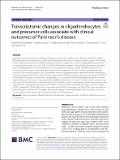Transcriptomic changes in oligodendrocytes and precursor cells associate with clinical outcomes of Parkinson’s disease
Author(s)
Dehestani, Mohammad; Kozareva, Velina; Blauwendraat, Cornelis; Fraenkel, Ernest; Gasser, Thomas; Bansal, Vikas; ... Show more Show less
Download13041_2024_Article_1128.pdf (3.639Mb)
Publisher with Creative Commons License
Publisher with Creative Commons License
Creative Commons Attribution
Terms of use
Metadata
Show full item recordAbstract
Several prior studies have proposed the involvement of various brain regions and cell types in Parkinson’s disease (PD) pathology. Here, we performed snRNA-seq on the prefrontal cortex and anterior cingulate regions from a small cohort of post-mortem control and PD brain tissue. We found a significant association of oligodendrocytes (ODCs) and oligodendrocyte precursor cells (OPCs) with PD-linked risk loci and report several dysregulated genes and pathways, including regulation of tau-protein kinase activity, regulation of inclusion body assembly and protein processing involved in protein targeting to mitochondria. In an independent PD cohort with clinical measures (681 cases and 549 controls), polygenic risk scores derived from the dysregulated genes significantly predicted Montreal Cognitive Assessment (MoCA)-, and Beck Depression Inventory-II (BDI-II)-scores but not motor impairment (UPDRS-III). We extended our analysis of clinical outcome prediction by incorporating differentially expressed genes from three separate datasets that were previously published by different laboratories. In the first dataset from the anterior cingulate cortex, we identified an association between ODCs and BDI-II. In the second dataset obtained from the substantia nigra (SN), OPCs displayed an association with UPDRS-III. In the third dataset from the SN region, a distinct subtype of OPCs, labeled OPC_ADM, exhibited an association with UPDRS-III. Intriguingly, the OPC_ADM cluster also demonstrated a significant increase in PD samples. These results suggest that by expanding our focus to glial cells, we can uncover region-specific molecular pathways associated with PD symptoms.
Date issued
2024-08-13Department
Massachusetts Institute of Technology. Department of Biological EngineeringJournal
Molecular Brain
Publisher
BioMed Central
Citation
Dehestani, M., Kozareva, V., Blauwendraat, C. et al. Transcriptomic changes in oligodendrocytes and precursor cells associate with clinical outcomes of Parkinson’s disease. Mol Brain 17, 56 (2024).
Version: Final published version